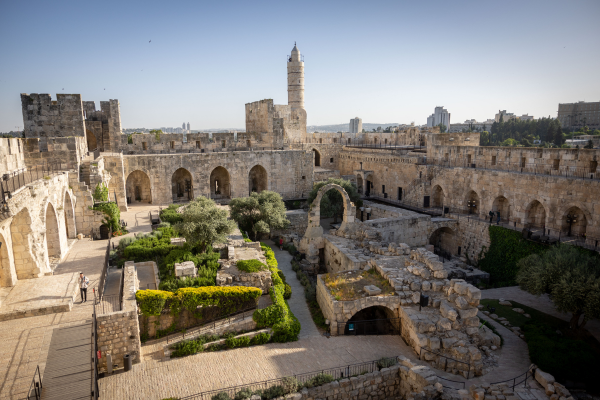The Tower of David Jerusalem Museum now boasts 10 galleries spread throughout the ancient citadel that bring the story of Jerusalem to life.
By JNS
A walk around the Tower of David is a one-stop shop for architecture in Jerusalem from the times of the kings of Judea in the First Temple period 2,800 years ago until today.
There are walls from the Hasmoneans, towers from King Herod, a banquet room from the Crusaders and arched walls from the Ottomans to name just a few.
Now the Tower of David Jerusalem Museum welcomes the latest layer in the Old City’s architecture with the addition of the Angelina Drahi Entrance Pavilion, which opens its doors next month.
After more than a decade of planning and three years of construction, the final part of the $50 million renewal of the Tower of David Jerusalem Museum is complete with the opening of the new multi-level sunken entrance pavilion.
The 1,000 square meter (10,763 square feet) building nestled between the walls of Jerusalem’s Old City and the ancient citadel walls is barely noticeable from the Jaffa Gate Plaza.
Building regulations forbid building above the height of the Old City walls, so the architects and engineers needed to plan for excavating the site 17 meters/18.6 yards down to build the pavilion that now houses the ticket office of the museum, a changing exhibition gallery, and a labyrinth of offices for the Education Department underground and a shaded seating area outside. In May, the coffee shop will open.
A duty and an honor
The ancient citadel was transformed into a welcoming and accessible environment under the direction of Kimmel Eshkolot Architects, Professor Etan Kimmel and lead architect Yotam Cohen-Sagi.
“The opportunity to bring the 21st century to this ancient iconic site is both a duty and an honor,” says Kimmel.
“We were set the task of renovating one of the earliest and most important architectural treasures of Jerusalem. Our challenge boiled down to our ability to find solutions to preserve the ancient stones that represent Jerusalem’s past without compromising their historic value or their beauty while planning new architectural structures and introducing modern infrastructure using modern materials to create a fruitful, interesting meeting between the new and the old,” he explains.
The first people to go on site were the archaeologists from the Israel Antiquities Authority.
“You only need to use a teaspoon to dig up antiquities in the Old City of Jerusalem, and this is even more true when you are building a structure underground next to a citadel thousands of years old,” says Cohen-Sagi.
No great treasures from Jerusalem’s past were found during construction and the building of the pavilion could go ahead as planned.
The renewal and conservation of the museum was led by the Clore Israel Foundation.
“No other museum can tell Jerusalem’s story in such a distinctive setting, within this citadel that has witnessed so many eventful periods in the city’s past,” says Eilat Lieber, director and chief curator of the museum.
“Alongside the physical conservation of the walls and towers of this ancient site, we have developed a completely new permanent exhibition and creative programming that tells Jerusalem’s long, complex and colorful history in respectful, innovative and engaging ways,” she adds.
The museum now boasts 10 galleries spread throughout the ancient citadel that bring the story of Jerusalem to life through ancient artifacts mixed with the latest in immersive and interactive technology.
The new pavilion allows for a change in the flow of visitors.
Jerusalem Mayor Moshe Lion says, “The new Tower of David Jerusalem Museum at the Jaffa Gate will serve as the new gateway to Jerusalem for the millions of visitors, tourists and pilgrims who want to explore the city’s rich and complex history before visiting the religious sites and ancient alleyways of the Old City.”
The entrance should have been opened on Nov. 3 but the Hamas war changed these plans. The museum opened on Oct. 9, the third day of the war, and has been running activities and guided tours for evacuated families, arts and crafts fairs for artists from the north and south as well as education programming for school children, all free of charge.
“When we opened the museum, we didn’t know who would come,” admits Lieber.
It quickly became clear that for the thousands of visitors who arrived, the museum offered a reprieve from the shadows of the war, she says. One visitor, who had been evacuated from Moshav Kfar Maimon, near the northern Gaza Strip, says that standing surrounded by the ancient Jerusalem stones gave a historical perspective and some hope.



